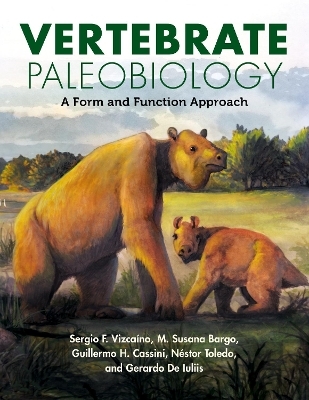
Vertebrate Paleobiology
Indiana University Press (Verlag)
978-0-253-07047-0 (ISBN)
- Lieferbar (Termin unbekannt)
- Versandkostenfrei
- Auch auf Rechnung
- Artikel merken
Paleobiology is the branch of evolutionary biology involved in the reconstruction of the life histories of extinct organisms. It answers the questions, How do we use fossils to reconstruct the size of prehistoric animals, and How did they move and feed? Drawing on a rich inventory of South American Miocene fossils, Vertebrate Paleobiology: A Form and Function Approach examines different aspects of functional morphology and how they are tested by paleontologists, anatomists, and zoologists.
Beginning with a review of various methodologies to interpret fossils, the authors turn to the main concepts important to functional morphology and give examples of each. They conclude by showing how functional morphology enables a dynamic, broadscale reconstruction of the life of prehistoric animals during the South American Miocene.
Originally published in Spanish, Vertebrate Paleobiology: A Form and Function Approach provides a broad sweep of recent developments, including theoretical and practical techniques, applied to the study of extinct vertebrates.
Sergio F. Vizcaíno is Professor of Vertebrate Zoology at Universidad Nacional de La Plata, Researcher of the Consejo Nacional de Investigaciones Científicas y Técnicas (CONICET), and Curator of Vertebrate Paleontology at the Museo de La Plata, Argentina. He is author (with Richard A. Farina and Gerardo De Iuliis) of Megafauna: Giant Beasts of Pleistocene South America. M. Susana Bargo is Researcher of the Comisión de Investigaciones Científicas de la Provincia de Buenos Aires (CIC PBA) and Associate Curator of Vertebrate Paleontology at the Museo de La Plata, Argentina. She is editor (with Sergio F. Vizcaíno, and Richard F. Kay) of Early Miocene Paleobiology in Patagonia: High-Latitude Paleocommunities of the Santa Cruz Formation. Guillermo H. Cassini is Professor of Structural and Functional Adaptations of Vertebrates at the Universidad Nacional de Luján, Researcher of the Consejo Nacional de Investigaciones Científicas y Técnicas (CONICET) at the Museo Argentino de Ciencias Naturales "Bernardino Rivadavia" (MACN-BR), Argentina, and Associate Curator from Colección Nacional de Mastozoología at the MACN-BR. Néstor Toledo teaches Comparative Anatomy at the Universidad Nacional de La Plata and is Researcher of the Consejo Nacional de Investigaciones Científicas y Técnicas (CONICET) at the Museo de La Plata, Argentina. Gerardo De Iuliis is Lecturer of Comparative Vertebrate Anatomy and Vertebrate Palaeontology at the University of Toronto, Professor of Anatomy and Physiology at George Brown College, and Research Associate at the Royal Ontario Museum, Canada. He is author (with Sergio F. Vizcaíno and Richard A. Farina) of Megafauna: Giant Beasts of Pleistocene South America.
Prologue
1. The Design of Fossil Vertebrates as a Tool for Interpreting Their Biology
2. Methodological Tools
3. Biomaterials
4. Body Size
5. Substrate Preference and Use: Locomotion in Fluids
6. Preference and Use of Substrate: Terrestrial Locomotion
7. Feeding: Food Diversity and Buccal Apparatuses in Vertebrates
8. Feeding: Analysis of the Cephalic Feeding System
9. Paleoecology
Epilogue
Appendix: Notions of Anatomy
References
| Erscheinungsdatum | 05.08.2024 |
|---|---|
| Reihe/Serie | Life of the Past |
| Zusatzinfo | 30 color illus., 13 b&w illus., 174 charts, 15 b&w tables |
| Verlagsort | Bloomington, IN |
| Sprache | englisch |
| Maße | 216 x 279 mm |
| Gewicht | 1089 g |
| Themenwelt | Sachbuch/Ratgeber ► Natur / Technik ► Natur / Ökologie |
| Sachbuch/Ratgeber ► Natur / Technik ► Naturwissenschaft | |
| Naturwissenschaften ► Geowissenschaften ► Mineralogie / Paläontologie | |
| ISBN-10 | 0-253-07047-3 / 0253070473 |
| ISBN-13 | 978-0-253-07047-0 / 9780253070470 |
| Zustand | Neuware |
| Haben Sie eine Frage zum Produkt? |
aus dem Bereich


